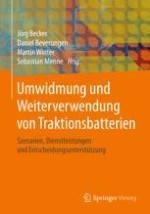2019 | OriginalPaper | Buchkapitel
2. End-of-Life-Strategien für Traktionsbatterien
verfasst von : Dr. Sebastian Bräuer, Dipl.-Ing. Alexander Stieger
Erschienen in: Umwidmung und Weiterverwendung von Traktionsbatterien
Verlag: Springer Fachmedien Wiesbaden
Aktivieren Sie unsere intelligente Suche, um passende Fachinhalte oder Patente zu finden.
Wählen Sie Textabschnitte aus um mit Künstlicher Intelligenz passenden Patente zu finden. powered by
Markieren Sie Textabschnitte, um KI-gestützt weitere passende Inhalte zu finden. powered by
